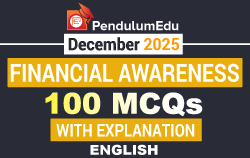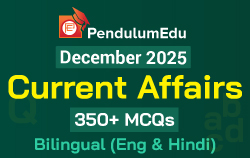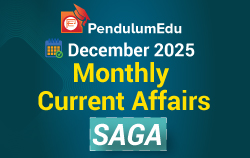Daily Current Affairs and GK | 28 March 2020

Happy New Year get 35% Off
Use Coupon code NY2026
1. Ministry of Health issued a notification to regulate the sale of hydroxychloroquine
- Recently, a notification has been issued by the Ministry of Health to regulate the sale of hydroxychloroquine as an essential drug.
- This drug is useful in the treatment of Covid-19 pandemic, so it has been declared an essential drug.
- The sale of hydroxychloroquine or any retail drug made from it will be regulated as per Schedule H-1 of the Drug and Cosmetics Rules of 1945.
- In view of the emergency requirements of the Covid-19 pandemic, the Central Government has placed hydroxychloroquine in the list of essential medicines in public interest.
2. Ministry of Home Affairs sanctioned an assistance of Rs. 5751 crore under National Disaster Response Fund
- Recently, in a high-level meeting chaired by Home Minister Amit Shah, an additional central assistance amount of Rs 5751 crore has been approved under National Disaster Response Fund.
- This amount will be provided to eight states affected by floods, landslides, cyclones and droughts last year.
- National Disaster Response Fund (NDRF):
- It is a fund managed by the central government to meet expenses for emergency response, relief and rehabilitation due to a dangerous disaster situation or disaster.
- This is defined in section 46 of the Disaster Management Act, 2005.
3. Supreme Court granted relief to motor vehicle dealers
- Recently, the Supreme Court gave relief to motor vehicle dealers and allowed them to sell BS-4 standard vehicles in the country for ten days.
- This exemption is not applicable in the National Capital Territory of Delhi.
- The sale can be made only after the end of the nationwide lockdown period.
- Earlier, the deadline for sale of BS-4 vehicles across the country was set as 31 March 2020.
- A bench of Justices Arun Mishra and Justice Deepak Gupta pronounced the decision through video conferencing.
- Both BS-4 and BS-6 are the maximum unit standards of pollutants in emissions by vehicles, which are set by the Government of India.
- BS-6 fuels emit up to 5 times less sulphur than current BS-4. It has 10 ppm sulphur as against 50 ppm in BS-4.
4. Prime Minister Narendra Modi called upon the leaders of the G20 for the welfare of mankind
- Prime Minister Narendra Modi has called upon the leaders for collective efforts towards the welfare of the mankind during the virtual G20 summit.
- In this meeting, the leaders of the G20 have agreed to take all necessary measures to prevent the pandemic and protect the people and have promised support through medical supplies, diagnostic equipment, treatments, medicines and vaccines.
- The G-20 countries have also decided to invest more than $ 5 trillion in the global economy to deal with the economic and social consequences of pandemic.
- These leaders will contribute voluntarily to the World Health Organization-led COVID-19 Solidarity Response Fund.
- G-20:
- G-20 is an international forum of 19 countries and governments of the European Union and the Governors of the Central Bank.
- It was founded in September 1999.
5. PESO took various measures to ensure oxygen supply
- The Petroleum and Explosives Safety Organization (PESO) has taken various measures to ensure supply of oxygen to hospitals and other health care centers for the prevention of Covid-19 pandemic.
- All its offices have been instructed by the peso to provide licenses for the storage and transportation of immediate oxygen.
- Petroleum and Explosives Safety Organization (PESO):
- It is an autonomous, regulatory authority.
- It was founded on 9 September 1898.
- Its headquarters is located in Nagpur.
6. Reserve Bank of India announced reduction in benchmark interest rates.
- Reserve Bank of India Governor Shaktikanta Das has announced a reduction in benchmark interest rates.
- The repo rate has been reduced by 75 basis points to 4.4%.
- The reverse repo rate has also been reduced by 90 basis points to 4.0%.
- Also, the cash reserve ratio (CRR) has been reduced from 4% to 3%.
- Apart from this, the Reserve Bank has given a relief of up to three months on the monthly payment of all loans.
- All these decisions have been taken to deal with the situation caused due to Covid-19 pandemic.
- Repo rate - This is the rate at which the country's central bank lends to commercial banks.
- Reverse Repo Rate - This is the rate at which commercial banks deposit their money with the central bank.
- Cash Reserve Ratio (CRR) - This is a fixed minimum deposit amount that commercial banks have to hold as reserves with the central bank.
7. India is planning to get a test kit from South Korea
- Currently India is planning to get a testing kit from South Korea for testing the Coranavirus infection.
- South Korea has overcome Covid-19 to a large extent by a screening process serological test.
- India is currently conducting RT-PCR tests only. The government has fixed a price of Rs 4,500 for RT-PCR testing in a private laboratory.
- ICMR has also asked suppliers to purchase 7 lakh RNA extraction kits.
- ICMR has invited manufacturers to supply 5 lakh antibody kits for diagnosis of coronavirus infection which will act as screening test for COVID-19.
Topic of the Day- "Himalayan Rivers"
There is a network of rivers in India and these rivers have always been the center of civilization. The rivers found in India can be mainly divided into two parts.
1. Himalayan Rivers
2. Rivers of peninsular India
Himalayan Rivers:
They are also known as perennial or the rivers of North India. Their main features are as follows-
- The Himalayan rivers have large basins as these rivers are fed by both melting snow and rainfall. Hence, they are perennial in nature.
- The Himalayan rivers cover long routes before falling into the sea.
- These rivers bring more sediment and silt due to the sedimentary characteristics of the Himalayas. Frequent flooding and devastation occur due to excess rainfall and large amounts of sediment brought by rivers. For example, due to the floods in the Kosi river, it is called the Sorrow of Bihar.
- Most of the Himalayan rivers are in their youth and along with upliftment of Himalayas they also have erosive activities. In this phase, deep U and V shaped valleys are formed. After entering the plains, they form figures such as ox-bow lakes, floodplains, hanging channels and deltas near the mouth of the river.
- Ganges, Brahmaputra and Indus are the major Himalayan rivers.
1. Indus
The Indus River is one of the largest river basins in the world. The Indus River flows through China (Tibet region), India and Pakistan. In Tibet, it is known as Singi Khambai or Lion's mouth.
Origin - The Indus River originates from a glacier near Bokhar Chu in the Tibet region which is in the Kailash Mansarovar Range near Mansarovar Lake.
The Indus river falls into the Arabian Sea near Pakistan's port city of Karachi after forming a huge delta.
The major tributaries of the left bank are Jaskar River, Suru River, Son River, Jhelum River, Chenab River, Ravi River, Beas River, Sutlej River.
The major tributaries of the right bank are Shyok River, Gilgit River, Hunza River, Swat River, Kunnar River, Kurram River and Kabul River.
2. Ganges
Origin - Ganges originates from Gangotri Glacier near Gomukh in Uttarakhand.
Diversion - The Ganges River flows through the states of Uttarakhand, Uttar Pradesh, Bihar, Jharkhand and West Bengal and eventually falls into the Bay of Bengal.
The major tributaries of its left bank are the Gomti River, the Ghaghra River, the Gandaki River and the Kosi River.
The major tributaries of the right bank are Yamuna River, Son River, Punpun and Damodar.
Five types of Prayag are made in the Ganges river which are as follows-
1. Devprayag - At the confluence of the Bhagirathi River and the Alaknanda River.
2. Rudraprayag - At the confluence of the Mandakini River and the Alaknanda River.
3. Nandaprayag- At the confluence of the Nandakini River and the Alaknanda River.
4. Karnaprayag- At the confluence of Pinder River and Alaknanda River.
5. Vishnuprayag- At the confluence of the Dhauliganga River and the Alaknanda River.
3. Brahmaputra
The Brahmaputra river system is one of the largest rivers in the world. In the Tibet region, it is known as Yarlung Tsangpo. It is known as Siang and Dihang in India. After joining it with two main tributaries, Dibang and Lohit, it is known as Brahmaputra. In Bangladesh it flows under the name Jumna. Finally, the Ganges merges into the river.
Majuli Island, the world's largest river island, is on the Brahmaputra River in the state of Assam.
Origin - The Brahmaputra River originates from the Kailash Range Chamundung Glacier near Mansarovar Lake, north of the Himalayas in Tibet.
The Brahmaputra falls into the Bay of Bengal before forming a huge delta along the Ganges.
The major tributaries of the left bank are Budhi Dihang, Dhansari and Kalang.
The major tributaries of the right bank are Subansiri, Kameng, Manas and Sankosh.
Multiple Choice Questions (MCQs)
1. According to the current orders, sales of hydroxychloroquine will be regulated under the Drug and Cosmetics Rules of which year?
A. 1956
B. 1968
C. 1945
D. 1975
2. Under which Act is the National Disaster Response Fund defined?
A. Disaster Management Act, 2007
B. Disaster Management Act, 2005
C. Disaster Management Act, 2009
D. Disaster Management Act, 2012
3. Which of the following pollutants in BS-6 standard fuels is emitted up to 5 times less than that in BS-4 fuels?
A. Carbon dioxide
B. Sulphur
C. Chlorine
D. Lead
4. When was the G20 group formed?
A. 1999
B. 1986
C. 1970
D. 1995
5. Where is the headquarters of the Petroleum and Explosives Safety Organization located?
A. Kanpur
B. Nagpur
C. Vijayawada
D. Kochi
6. The cash reserve ratio has been reduced by RBI to_______.
A. 3.5%
B. 3%
C. 4%
D. 2%
7. At present, from which country India is planning to get testing kit for Coronavirus?
A. Russia
B. USA
C. South Korea
D. Cuba
Solution
1. C
2. B
3. B
4. A
5. B
6. B
7. C





 27 March 2020 Current Affairs
27 March 2020 Current Affairs 








Comments